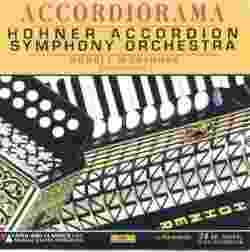
Program:
Johann Strauss Jr. (1825 - 1899): Perpetuum mobile, Op. 257 "Musikalischer Scherz"
Franz Liszt (1811 - 1886): Hungarian Rhapsody No. 2 in C sharp minor
Rudolph Würthner: Concert Etude on a Theme of Paganini "La Campanella"
Carl Maria von Weber (1786 - 1826): Invitation to the Dance
Johannes Brahms (1833 - 1897): Hungarian Dances Nos. 5 and 6
Gioacchino Rossini (1792 - 1868):Guillaume Tell: Overture
Grigoras Dinicu (1889 - 1948): Hora Staccato
Amilcare Ponchielli (1834 - 1886): La Gioconda: Dance of the Hours
Total Time: 53:24
Date of LP Release: 1961
Date of CD Release: 1997
Review Date: July 2001
Label: Omega Record Group http://www.omegarecords.com
Review by Henry Doktorski:
Credit for much of the growth of the classical accordion must go to the Hohner company which began manufacturing accordions shortly after the turn of the century. Christoph Wagner wrote, "In the late 1920's, Hohner came up with a new idea for enlarging the market for the instrument. They decided to improve its public image by turning it from a folk instrument played by ear to a respectable instrument played from sheet music. A model 'accordion orchestra' of around thirty skilled amateurs was put together and toured extensively by bus throughout Germany and the neighboring countries presenting the new concept to the public. Hohner also began to publish sheet music of classical pieces and established a college for accordion teachers to 'raise the standard.' The response was enormous." (see footnote)This is a recording by the famed "Hohner Accordion Symphony Orchestra," recorded at Baumgarten Hall in Vienna in 1961 and digitally remastered for compact disc. It is amazing. Such a beautiful sound. Full. Refined. Sophisticated. There is great contrast here; a requirement for such great classical orchestral standards. The group achieves this contrast in no small regard because of the inclusion in the ensemble of the electronium, a primitive electronic accordion invented and marketed by the Hohner company sometime around 1951. I may write "primitive" but the sometimes brassy, sometimes bassoon-like, sometimes harp-like and sometimes flute-like sounds it makes contribute wonderfully to the musical texture.
The music the orchestra performs on this recording, interestingly enough, consists of that very music which accordions were prohibited from playing in Germany of the 1930s. Wagner continued, "when the Nazis came to power, the growth of the accordion slowed down. The propagandists claimed that the accordion was a 'nigger jazz instrument' for its close connection with modern American dance music. The Nazis tried to stop accordion bands from playing classical music which for them was an 'abuse of the music of our great masters.' The president of the reichsmusikkammer -- the highest institution controlling music in the Third Reich — declared that 'now is the time to build a dam against the flooding of our musical life by the accordion.'"
Fortunately the decision to ban the accordion seemed to have never been enforced. Perhaps the president of the reichsmusikkammer might have actually had a chance to hear the Hohner orchestra in person?
Of special note is "Hora Staccato" which features the chromatic harmonica playing of Günther Wertz. This CD is something no classical accordion lover will want to miss.
Foonote: Christoph Wagner, "A Brief History of How the Accordion Changed the World," CD booklet notes for Planet Squeezebox, performed by various artists, (Roslyn, New York: Ellipsis Arts, 1995), 6.
| About The Free-Reed Review |
| Invitation to Contributors / Submission Guidelines |
| Back to The Free-Reed ReviewContents Page |
| Back to The Classical Free-Reed, Inc. Homepage |